Abstract
The main objective of the present paper is to determine the influence of rub parameters on the stability of a two-spool rotor system undergoing rub-impact. The parameters such as rotor–stator contact stiffness, coefficient of friction and clearance are varied for understanding their effects on the system response and stability. Moreover, the analysis is performed for two modes of rotor operations, namely co-rotation and counter-rotation, and determines their impacts on rotor–stator rubbing. A time variational method is employed to predict the nonlinear response of the system with a perturbation function applied at the steady-state solution points to investigate their stability. Two types of bifurcations, namely limit point and Neimark–Sacker bifurcations, are observed in the response by monitoring the Floquet exponents of the perturbed system. As the coefficient of friction is increased, the early onset of NS bifurcation has happened and the system enters into the quasi-periodic regime early. However, when the contact stiffness and clearance values are increased, the onset of NS bifurcation is delayed. It is also observed that the response characteristics of the co- and counter-rotating systems are entirely different. The separation between forward and backward whirling frequencies is reduced for the counter-rotating system due to the cancellation of gyroscopic moments. In addition, for the same set of parameters, the counter-rotating system enters into the quasi-periodic regime quickly once the disk starts rubbing.
































Similar content being viewed by others
References
Prabith, K., Krishna, I.P.: The numerical modeling of rotor-stator rubbing in rotating machinery: a comprehensive review. Nonlinear Dyn. 101, 1317–1363 (2020)
Yang, Y., Cao, D., Yu, T., Wang, D., Li, C.: Prediction of dynamic characteristics of a dual-rotor system with fixed point rubbing-theoretical analysis and experimental study. Int. J. Mech. Sci. 115, 253–261 (2016)
Wang, N., Jiang, D., Behdinan, K.: Vibration response analysis of rubbing faults on a dual-rotor bearing system. Arch. Appl. Mech. 87(11), 1891–1907 (2017)
Yang, Y., Cao, D., Wang, D., Jiang, G.: Response analysis of a dual-disc rotor system with multi-unbalances-multi-fixed-point rubbing faults. Nonlinear Dyn. 87(1), 109–125 (2017)
Yang, Y., Cao, D., Wang, D., Jiang, G.: Fixed-point rubbing characteristic analysis of a dual-rotor system based on the Lankarani–Nikravesh model. Mech. Mach. Theory 103, 202–221 (2016)
Lankarani, H.M., Nikravesh, P.E.: A contact force model with hysteresis damping for impact analysis of multibody systems. J. Mech. Des. 112(3), 369–376 (1990)
Lu, Z., Zhong, S., Chen, H., Wang, X., Han, J., Wang, C.: Nonlinear response analysis for a dual-rotor system supported by ball bearing. Int. J. Non-Linear Mech. 128, 103–627 (2021)
Gao, T., Cao, S., Zhang, T.: Theoretical and experimental study on the transient time-frequency characteristics of the bending-torsional coupling motions of a rub-impact dual-rotor system. Shock Vib. 2021, 8817228.1–17 (2021)
Wang, N., Liu, C., Jiang, D., Behdinan, K.: Casing vibration response prediction of dual-rotor-blade-casing system with blade-casing rubbing. Mech. Syst. Signal Process. 118, 61–77 (2019)
Yang, Y., Ouyang, H., Yang, Y., Cao, D., Wang, K.: Vibration analysis of a dual-rotor-bearing-double casing system with pedestal looseness and multi-stage turbine blade-casing rub. Mech. Syst. Signal Process. 143, 106–845 (2020)
Sun, C., Chen, Y., Hou, L.: Steady-state response characteristics of a dual-rotor system induced by rub-impact. Nonlinear Dyn. 86(1), 91–105 (2016)
Hou, L., Chen, Y., Fu, Y., Chen, H., Lu, Z., Liu, Z.: Application of the HB-AFT method to the primary resonance analysis of a dual-rotor system. Nonlinear Dyn. 88(4), 2531–2551 (2017)
Hou, L., Chen, H., Chen, Y., Lu, K., Liu, Z.: Bifurcation and stability analysis of a nonlinear rotor system subjected to constant excitation and rub-impact. Mech. Syst. Signal Process. 125, 65–78 (2019)
Sun, C., Chen, Y., Hou, L.: Nonlinear dynamical behaviors of a complicated dual-rotor aero-engine with rub-impact. Arch. Appl. Mech. 88(8), 1305–1324 (2018)
Guskov, M., Thouverez, F.: Harmonic balance-based approach for quasi-periodic motions and stability analysis. J. Vib. Acoust. 134(3), 031 003.1-11 (2012)
Rook, T.: An alternate method to the alternating time-frequency method. Nonlinear Dyn. 27(4), 327–339 (2002)
Krishna, I.P., Padmanabhan, C.: Improved reduced order solution techniques for nonlinear systems with localized nonlinearities. Nonlinear Dyn. 63(4), 561–586 (2011)
Praveen Krishna, I., Padmanabhan, C.: Experimental and numerical investigations on rotor-stator rub. Proc. Inst. Mech. Eng. Part C J. Mech. Eng. Sci. 232(18), 3200–3212 (2018)
Prabith, K., Krishna, I.: A time variational method for the approximate solution of nonlinear systems undergoing multiple-frequency excitations. J. Comput. Nonlinear Dyn. 15(3), 031 006.1-11 (2020)
Wang, F., Luo, G.H., Yan, S., Cui, H.T.: A comparison study on co-and counterrotating dual-rotor system with squeeze film dampers and intermediate bearing. Shock Vib. 2017, 5493763.1–25 (2017)
Ma, X., Ma, H., Zeng, J., Piao, Y.: Rubbing-induced vibration response analysis of dual-rotor-casing system. Trans. Nanjing Univ. Aeronaut. Astronaut. 35(1), 101–108 (2018)
Fei, Zx, Tong, Sg, Wei, C.: Investigation of the dynamic characteristics of a dual rotor system and its start-up simulation based on finite element method. Jo. Zhejiang Univ. Sci. A 14(4), 268–280 (2013)
Friswell, M.I., Penny, J.E., Garvey, S.D., Lees, A.W.: Dynamics of Rotating Machines, 1st edn. Cambridge University Press, New York (2010)
Detroux, T., Renson, L., Masset, L., Kerschen, G.: The harmonic balance method for bifurcation analysis of large-scale nonlinear mechanical systems. Comput. Methods Appl. Mech. Eng. 296, 18–38 (2015)
Xie, L., Baguet, S., Prabel, B., Dufour, R.: Bifurcation tracking by harmonic balance method for performance tuning of nonlinear dynamical systems. Mech. Syst. Signal Process. 88, 445–461 (2017)
Author information
Authors and Affiliations
Corresponding author
Additional information
Publisher's Note
Springer Nature remains neutral with regard to jurisdictional claims in published maps and institutional affiliations.
Rights and permissions
About this article
Cite this article
Prabith, K., Krishna, I.R.P. The stability analysis of a two-spool rotor system undergoing rub-impact. Nonlinear Dyn 104, 941–969 (2021). https://doi.org/10.1007/s11071-021-06370-x
Received:
Accepted:
Published:
Issue Date:
DOI: https://doi.org/10.1007/s11071-021-06370-x




